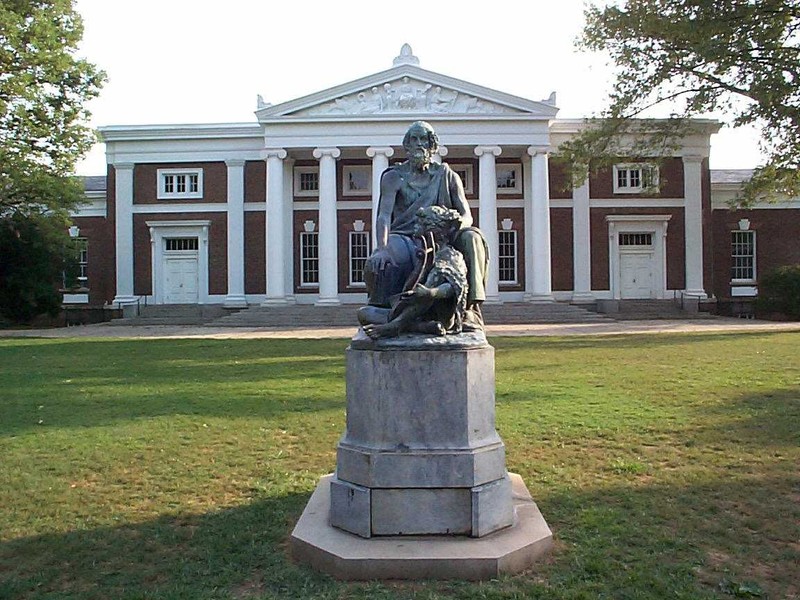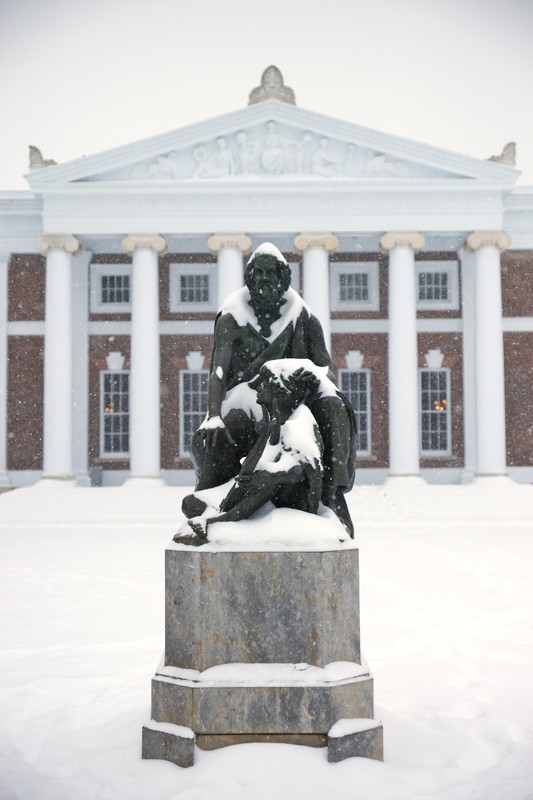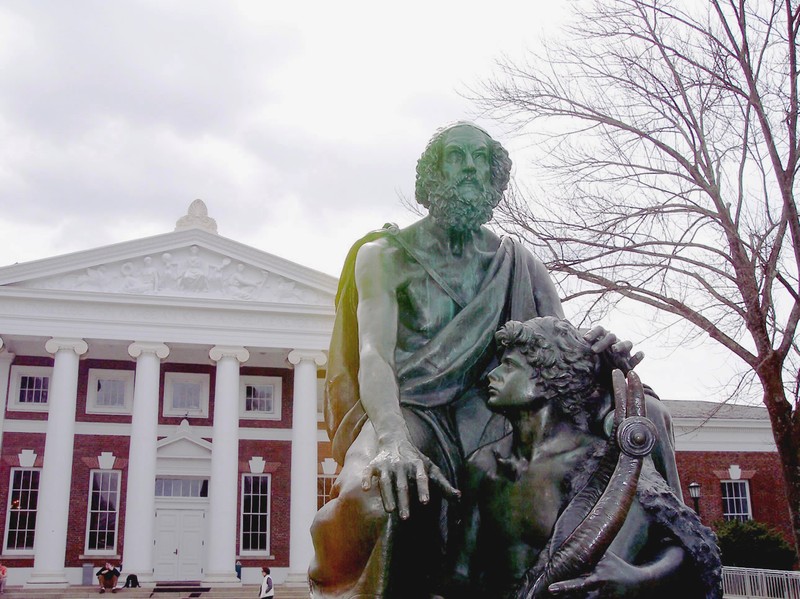Blind Homer With His Student Guide (Sculpture)
Introduction
Text-to-speech Audio
Blind Homer With His Student Guide is a bronze sculpture by noted Jewish American soldier and artist Moses Jacob Ezekiel. It depicts the Greek poet Homer, author of the Illiad and the Odyssey, accompanied by an Egyptian student guide. The statue was completed and acquired by U.Va in 1907, along with a bronze of Thomas Jefferson. The Homer sculpture is located on "The Lawn" at the University of Virginia in front of Cabell Hall.
Images
Homer Statue in front of Old Cabell Hall at U.Va; image by Philip Larson, Statue: Moses Jacob Ezekiel - flickr, CC BY-SA 2.0, https://commons.wikimedia.org/w/index.php?curid=3775752

Homer Statue in winter; image by Karen Blaha - http://www.flickr.com/photos/vironevaeh/4318680811, CC BY-SA 2.0, https://commons.wikimedia.org/w/index.php?curid=35197409

Homer Sculpture (detail); image by BSD, https://commons.wikimedia.org/w/index.php?curid=461218

Backstory and Context
Text-to-speech Audio
Blind Homer With His Student Guide is a bronze figure depicting a man, thought to be the ancient bard Homer, clad in classical garb. He sits on a bench covered with a cloth and is attended to by a youthful student guide. Homer has placed his left hand on the guide's head. The young Egyptian assistant, facing east, carries in his left hand a writing tablet or musical instrument. The sculpture sits on a base of Black marble, donated by the artist. The dimensions are approximately: 6 x 3 x 5 ft. (figure group); 41 x 48 x 64 in. (upper base); 7 x 67 x 140 in. (lower base).
This sculpture was created in 1907 by Virginia native Moses Jacob Ezekiel (October 28, 1844 – March 27, 1917) from his studio in Rome. The statue was commissioned by J.W. Simpson, a New York lawyer who presented it to Amherst College as a gift. For unknown reasons, Amherst refused the sculpture. Thomas Nelson Page, an active member of the U.Va Alumni Association who had visited Ezekiel's studio, contacted U.Va President Edwin Alderman about securing the work for the university. Ezekiel visited the campus and chose the South Lawn, where the Cabell, Cocke, and Rouss Halls were just being completed, as the location for the piece.
Of the sculpture, Simpson wrote in 1906:
This sculpture was created in 1907 by Virginia native Moses Jacob Ezekiel (October 28, 1844 – March 27, 1917) from his studio in Rome. The statue was commissioned by J.W. Simpson, a New York lawyer who presented it to Amherst College as a gift. For unknown reasons, Amherst refused the sculpture. Thomas Nelson Page, an active member of the U.Va Alumni Association who had visited Ezekiel's studio, contacted U.Va President Edwin Alderman about securing the work for the university. Ezekiel visited the campus and chose the South Lawn, where the Cabell, Cocke, and Rouss Halls were just being completed, as the location for the piece.
Of the sculpture, Simpson wrote in 1906:
I am delighted with the spirit with which you accept the Homer group of Moses Ezekiel. My own college having no suitable place for it, the University of Virginia seemed to me its natural home.1Moses Jacob Ezekiel was the first Jewish cadet to attend the Virginia Military Institute and a Civil War veteran, where he fought for the Confederate Army. He is buried in Arlington National Cemetery near one of his own pieces: The Confederate Soldier's Memorial. He is also the artist responsible for the Jefferson Statue in front of the Rotunda.
Sources
1. Roberts, Josie. "Homer's Odyssey brings him to Lawn." The Cavalier Daily (University of Virginia), April 4, 2000. Accessed January 11, 2017. http://www.cavalierdaily.com/article/2000/04/homers-odyssey-brings-him-to-lawn/.
"Homer (Ezekiel)." Wikipedia, the Free Encyclopedia. Accessed January 11, 2017. https://en.wikipedia.org/wiki/Homer_(Ezekiel).
"Homer, (sculpture)." Smithsonian Institution Research Information System. Accessed January 11, 2017. http://siris-artinventories.si.edu/ipac20/ipac.jsp?&profile=all&source=~!siartinventories&uri=full=3....
"Moses Jacob Ezekiel." Wikipedia, the Free Encyclopedia. Accessed January 11, 2017. https://en.wikipedia.org/wiki/Moses_Jacob_Ezekiel.
"Homer (Ezekiel)." Wikipedia, the Free Encyclopedia. Accessed January 11, 2017. https://en.wikipedia.org/wiki/Homer_(Ezekiel).
"Homer, (sculpture)." Smithsonian Institution Research Information System. Accessed January 11, 2017. http://siris-artinventories.si.edu/ipac20/ipac.jsp?&profile=all&source=~!siartinventories&uri=full=3....
"Moses Jacob Ezekiel." Wikipedia, the Free Encyclopedia. Accessed January 11, 2017. https://en.wikipedia.org/wiki/Moses_Jacob_Ezekiel.
